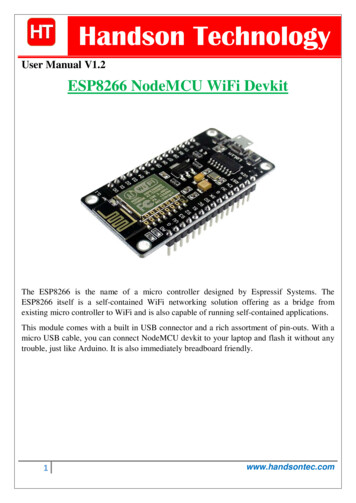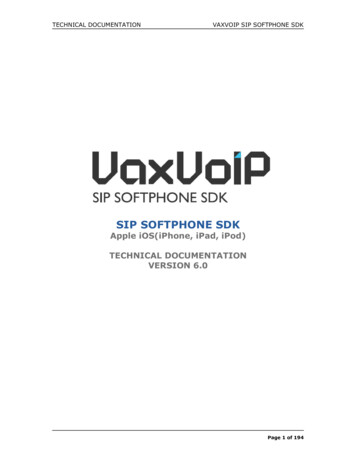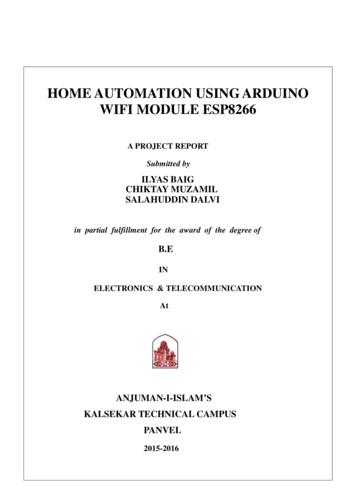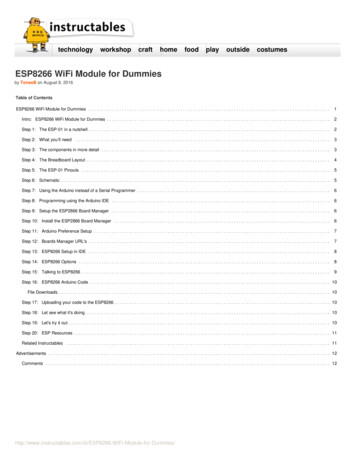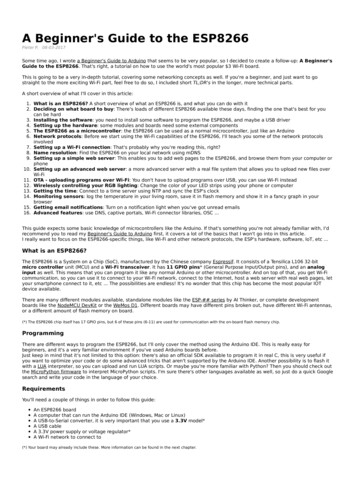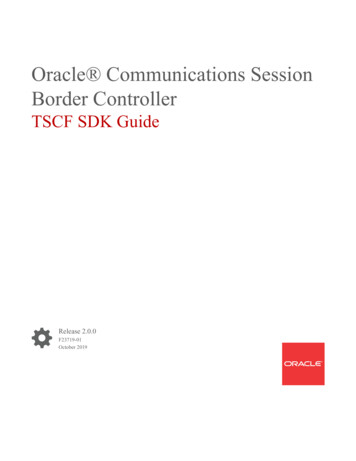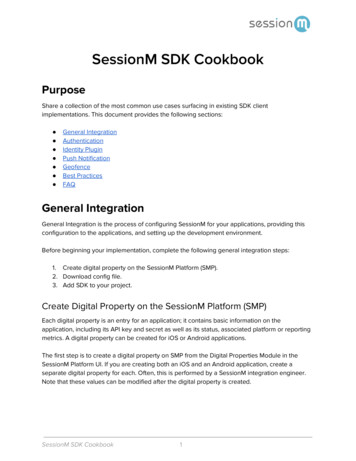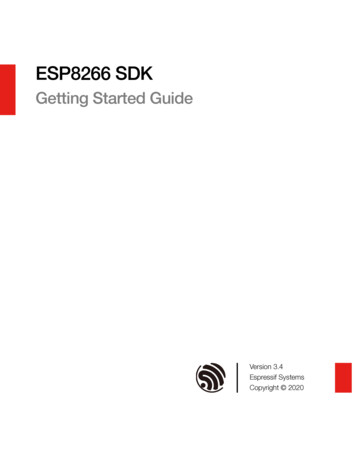
Transcription
ESP8266 SDKGetting Started GuideVersion 3.4Espressif SystemsCopyright 2020
About This GuideThis document takes ESP-LAUNCHER and ESP-WROOM-02 as examples to introducehow to use the ESP8266 SDK V2.X and earlier versions. The contents include preparationsbefore compilation, SDK compilation and firmware download.For the new ESP8266 RTOS SDK (ESP-IDF style) V3.0 and later versions, please seeESP8266 RTOS SDK/docs.Release NotesDateVersionRelease notes2016.04V2.0First release.2016.07V2.12016.07V2.2Updated Section 3.3.1.2016.08V2.3Updated the Baidu link in Section 3.3.1.2016.10V2.4Updated the flash address of eagle.irom0.text.bin in Section 4.1.1.2016.11V2.5Added Appendix B—Learning Resources.Added MXIC Flash QIO mode;Modified the default value of byte 112 to 0.Modified the default value of byte 113 to 0 in Table 6-6.2017.01V2.6Added two Github links of RTOS and non-OS SDK sample code inAppendix B.2—Must-Have Resources.Updated sections 3.1 and 3.2;2017.02V2.7Updated the link for the OVA image file in section 3.3.1;Updated Section 5.1.2.2017.05V2.8Updated Chapter 4 for 8 MB and 16 MB flash support.Updated Table 1-1 in Chapter 1;2017.11V2.9Updated Figure 4-1 and the parameter descriptions in Chapter 4;Updated Table 4-1, Table 4-2, Table 4-3 and Table 4-4 in Chapter .09V3.4Updated section 4.1.1;Updated Table 4-1 in Chapter 4.Updated Table 4-3 in Chapter 4.2.1.Updated the description in Appendix A;Updated the document format.Updated the description of ESP8266 RTOS SDK (ESP-IDF style)V3.0 and later versions in About this Guide.Removed section 6.3;Removed some obsolete links.
Documentation Change NotificationEspressif provides email notifications to keep customers updated on changes totechnical documentation. Please subscribe at onDownload certificates for Espressif products from https://www.espressif.com/en/certificates.
Table of Contents1. Overview . 11.1. Procedure Overview .11.2. ESP8266 HDK .11.3. ESP8266 SDK .21.3.1.Non-OS SDK. 21.3.2.RTOS SDK .21.4. ESP8266 FW .21.5. ESP8266 Toolkit .31.5.1.Compiler .31.5.2.Firmware Download Tool .31.5.3.Serial Port Debug Tool .32. Preparing the Hardware .52.1. ESP-LAUNCHER .52.2. ESP-WROOM-02 .63. Preparing the Software .83.1. Non-OS SDK .83.2. RTOS SDK .83.3. ESP8266 Toolkit .103.3.1.Compiler .103.3.2.Firmware Download Tool .124. Flash Maps. 134.1. Non-OTA .144.1.1.Flash Map .144.1.2.Download Addresses.154.2. OTA Firmware .154.2.1.Flash Map .154.2.2.Download Addresses.165. Compiling the SDK .175.1. Preparations .175.1.1.Modifying SDK Files .17
5.1.2.Downloading SDK Files . 185.2. Compilation .195.2.1.Compile ESP8266 NONOS SDK v0.9.5 and Later Versions .195.2.2.ESP8266 NONOS SDK v0.9.4 and Earlier Versions .206. Downloading the Firmware . 216.1. Download Procedure . 216.2. Check Log File .236.2.1.ESP8266 IOT Demo .236.2.2.ESP8266 AT . 24A. Appendix—Configuring Flash DIO to QIO Mode. 25B. Appendix—Learning Resources .26B.1. Must-Read Documents .26B.2. Must-Have Resources .26
1. Overview!1.Overview1.1. Procedure OverviewFigure 1-1 shows the overall procedure of the SDK compilation.Chapter 3. Preparing the SoftwareTool DownloadChapter 2. Preparing the HardwareSDK DownloadESP-WROOM-02ESP-LAUNCHERChapter 4. FlashMapCompilerESP8266 SDKTool DownloadESP8266 FWChapter 5.Compiling the SDKESP8266 HDKChapter 6.Downloading the FirmwareESP8266 Toolkit!Figure 1-1 Procedure Overview1.2. ESP8266 HDKThe ESP8266 HDK (Hardware Development Kit) includes the chip—ESP8266EX, themodule—ESP-WROOM-02 and the development board—ESP-LAUNCHER. Users candownload the pre-compiled firmware using ESP-WROOM-02 or ESP-LAUNCHER. Notes: EspressifIf users use other development boards or modules that integrate ESP8266EX, please use thedevelopment firmware provided by the corresponding manufacturers.If users would like to purchase ESP-WROOM-02 or ESP-LAUNCHER, please visit Espressif’s officialonline store at: https://espressif.taobao.com,! /2812020.09
1. Overview!1.3. ESP8266 SDKThe ESP8266 Software Development Kit (SDK) is an Internet of Things (IoT) applicationdevelopment platform developed by Espressif for developers. It includes such examples ofapplication development as Smart Lights and Smart Plugs.Depending on whether they are based on an operating system (OS), SDKs can becategorized into two types: Non-OS SDK and RTOS SDK.1.3.1. Non-OS SDKNon-OS SDK is not based on an operating system. It supports the compilation ofIOT Demo and AT commands. Non-OS SDK uses timers and callbacks as the main way toperform various functions such as nested events and functions triggered by certainconditions. Non-OS SDK uses the espconn network interface; users need to develop theirsoftware according to usage rules of the espconn interface.1.3.2. RTOS SDKRTOS SDK is based on FreeRTOS, open-source software development on Github. The FreeRTOS SDK is based on FreeRTOS , a multi-tasking OS. Users can usestandard interfaces to realize resource management, recycling operations, executiondelays, inter-task messaging and synchronization, and other task-oriented processdesign approaches. For the specifics of interface methods, please refer to the officialwebsite of FreeRTOS or USING THE FreeRTOS REAL TIME KERNEL—A PracticalGuide The network operation interface in RTOS SDK is the standard lwIP API. RTOS SDKprovides a package which enables a BSD Socket API interface. Users can directlyuse the socket API to develop software applications; and port to ESP8266 otherapplications from other platforms using the socket API, effectively reducing thelearning costs arising from switching platforms. RTOS SDK introduces cJSON library whose functions make it easier to parse JSONpackets. RTOS is compatible with non-OS SDK in Wi-Fi interfaces, SmartConfig interfaces,Sniffer related interfaces, system interfaces, timer interfaces, FOTA interfaces andperipheral driver interfaces, but does not support AT implementation.1.4. ESP8266 FWESP8266 FW (Firmware) has been provided in binary format files (.BIN) that can bedownloaded directly to the HDK. Users can choose between Over-The-Air (OTA) and nonOTA firmware. For detailed information, please refer to Table 1-1.Espressif! /2822020.09
1. Overview!Table 1-1. ESP8266 FWBinariesCompulsory oroptionalDescriptionNon-OTAOTAesp init data default.bin CompulsoryDefault system parametersprovided in SDK. blank.binCompulsoryDefault system parametersprovided in SDK. eagle.flash.binCompulsoryMain program compiled from SDK. eagle.irom0text.binCompulsoryMain program compiled from SDK. boot.binCompulsoryBootloader provided in SDK. user1.binCompulsory forfirst usageMain program compiled from SDK. user2.binUsed in firmwareupgradeMain program compiled from SDK. Notes: For the contents of SDK, please refer to Chapter 3, "Preparing the Software". For SDK compilation, please refer to Chapter 5, "Compiling the SDK". For the addresses of binaries in the flash, please refer to Chapter 4, "Flash Maps".1.5. ESP8266 Toolkit1.5.1. CompilerLinux OS is required to compile the ESP8266 SDK. When using Windows OS, werecommend VirtualBox as the virtual machine for ESP8266. In order to simplify thecompilation procedure, we have installed the compiling tools on the virtual machine. Userscan directly compile the ESP8266 SDK by importing the ESP8266 compiler (OVA image)into the virtual machine.1.5.2. Firmware Download ToolThe ESP8266 DOWNLOAD TOOL is the official firmware download tool developed byEspressif. Users can download multiple binaries to the SPI Flash of the ESP8266 motherboard (ESP-LAUNCHER or ESP-WROOM-02) at the same time according to the actualcompilation mode and flash size.1.5.3. Serial Port Debug ToolThe serial port debug tool can be used to directly communicate with the ESP8266 moduleover a standard RS-232 port. For PCs that do not have a physical serial port, a virtual comport (USB-to-serial converter) can be used.Espressif! /2832020.09
1. Overview!Users may directly input commands into the terminal and view or record responses in realtime. Note:We recommend CoolTerm (for Windows and Mac OS) and Minicom (for Linux OS) as the serial portdebug tool.Espressif! /2842020.09
2. Preparing the Hardware!2.Preparing the HardwareDepending on whether the ESP-LAUNCHER or the ESP-WROOM-02 is used, users willneed either of the hardware mentioned in Table 2-1 below:Table 2-1. Hardware PreparationsESP-LAUNCHERESP-WROOM-02 1 ESP-WROOM-02 1 ESP-LAUNCHER 1 USB-to-TTL converter (FT232R recommended) 1 USB cable 6 Dupont lines 1 soldering tool suiteOR!!!!1 PC with pre-installed Windows OS Notice:The ESP8266 Wi-Fi module needs a 3.3V power supply and may draw a minimum current of 500 mA.2.1. ESP-LAUNCHER1. Connect PC to the USB-UART interface of ESP-LAUNCHER using the USB cable.2. Set ESP-LAUNCHER to download mode.StepsResult Slide Power Switch towards the outerGPIO0 ControlChip Switchside as the figure on the right shows.1 Slide GPIO0 Control towards the innerUSB-UARTside to enable ESP-LAUNCHER'sdownload mode. Notice:J82 must be shorted by a jumper,otherwise code cannot be downloadedto the board.EspressifUSB-serial Cable1!! /!285Power SwitchJ822020.09
2. Preparing the Hardware!3. Connect the USB-to-TTL converter to the PC. Note:Make sure that the proper driver for the USB-to-TTL converter is installed and recognized by the PC.4. Power on ESP-LAUNCHER by sliding the Power Switch towards the inner side.5. Power on the chip by sliding the Chip Switch towards the outer side.6. Download firmware to flash with the ESP8266 DOWNLOAD TOOL. Note:On how to download firmware, please refer to Chapter 4, "Flash Map" and Chapter 6, "Downloading theFirmware".7. After downloading, slide the GPIO0 Control towards the outer side to enable ESPLAUNCHER's working mode.8. Power on the chip again with the Chip Switch and the chip will read and run programsfrom the flash.2.2. ESP-WROOM-021. Lead out the pins of the ESP-WROOM-02, as shown in Table 2-2.Table 2-2. ESP-WROOM-02 PinsPinPin statusENPull up3V33.3V power supply (VDD)IO15Pull downIO0FigureUART download: pull down;Flash boot: floating/pull upGNDGNDRXDReceive-end in UART downloadTXDTransmit-end in UART download;floating/pull up!2. Connect ESP-WROOM-02 to the USB-to-TTL converter, using Dupont lines, as shownin Figure 2-1.Espressif! /!2862020.09
2. Preparing the Hardware!ESP-WROOM-02USB-to-TTL re 2-1. ESP-WROOM-02 Download Mode3. Connect the USB-to-TTL converter to the PC.4. Download firmware to flash with the ESP8266 DOWNLOAD TOOL. Note:On how to download firmware, please refer to Chapter 4, "Flash Maps" and Chapter 6, "Downloading theFirmware".5. After downloading, switch ESP-WROOM-02 to working mode.Set IO0 as floating or pull-up.6. Power on ESP-LAUNCHER again and the chip will read and run programs from theflash.—— Notes: IO0 is an internal pull-up pin. For more information on ESP-WROOM-02 hardware, please refer to ESP-WROOM-02 Datasheet.Espressif! /!2872020.09
3. Preparing the Software!3.Preparing the Software3.1. Non-OS SDKUsers can download the non-OS SDK (including application examples) sdks-demos?keys &field type tid%5B%5D 14.Figure 3-1 shows the directory structure of the non-OS SDK.!Figure 3-1. Non-OS SDK Directory Structure bin: compiled binaries to be downloaded directly into the flash. documents: SDK-related documents or links. driver lib: library files that drive peripherals, such as UART, I2C and GPIO. examples: sample codes for secondary development, for example, IoT Demo. include: header files pre-installed in SDK. The files contain relevant API functions andother macro definitions. Users do not need to modify them. ld: linker scripts. We suggest users not modifying them without any specific reasons. lib: library files provided in SDK. tools: tools needed for compiling binaries. Users do not need to modify them.3.2. RTOS SDKUsers can download RTOS SDK and its application examples from: RTOS SDKhttps://github.com/espressif/ESP8266 RTOS SDKTable 3-2 shows the directory structure of the RTOS SDK.Espressif! /!2882020.09
3. Preparing the Software!!Figure 3-2. RTOS SDK Directory Structure bin: boot and initialization firmware. documents: ESP8266 RTOS SDK files. driver lib: sample codes of drivers. examples: sample codes for Espressif’s application programs.- openssl demo: sample codes of the openssl API function.- project template: sample codes of project templates.- smart config: sample codes of SmartConfig.- spiffs test: sample codes of the spiffs file system function.- websocket demo: sample codes of web socket. include: header files of ESP8266 RTOS SDK, including software interfaces andmacro functions for users to use. ld: link files used when compiling; users do not need to modify them. lib: library file of ESP8266 RTOS SDK. third party: third-party library of Espressif’s open-source codes, currently includingfree RTOS, JSON, lwIP, mbedTLS, noPoll, OpenSSL, spiffs, and SSL. tools: tools needed for compiling binaries; users do not need to modify them.Espressif! /!2892020.09
3. Preparing the Software!3.3. ESP8266 Toolkit3.3.1. CompilerPlease download VirtualBox from: https://www.virtualbox.org/wiki/Downloads. Note:Please choose the right version of VirtualBox according to the host machine's OS.Please download the compiler ESP8266 lubuntu 20141021.ova from:http://downloads.espressif.com/FB/ESP8266 GCC.zipStepsResults1. Start Windows OS and install the virtual machine. Double-clickVirtualBox-5.0.16-105871-Win.exeand install VirtualBox. Note:VirtualBox has different versions. Weare using Windows V.5.0.16 as anexample. Double-click Oracle VMVirtualBox.exe to run the program,and the system will show the mainmenu . Tip:The ESP8266 virtual machine takesup much space (memory). Pleasereserve enough space for it.!2. Import the image file.Espressif! /! 28102020.09
3. Preparing the Software!StepsResults Select File Import Appliance, anda dialog box will show up . Select the image file to import, forexample, C:\ESP8266 lubuntu 20141021.ova,and click Next. Click Import to confirm the settings.3. Create a shared folder. Create a new folder named D:\VM\share. Select Machine Settings Shared Folders , and a dialog boxwill show up . Select the shared folder in MachineFolders, for example, D:\VM\share.4. Run the virtual machine.Espressif! /! 28112020.09
3. Preparing the Software!StepsResults After importing, a virtual machinenamed ESP8266 lubuntu shows up . Double-click ESP8266 lubuntu orStart to run the virtual machine. The system shows the ESP8266virtual machine . If a dialog box like the one below shows up, please enter thepassword: espressif.!3.3.2. Firmware Download ToolPlease download the ESP8266 DOWNLOAD TOOL er-tools.Espressif! /! 28122020.09
4. Flash Maps!4.Flash MapsThis chapter provides the flash maps for OTA firmware and non-OTA firmware in flashmemories with a different capacity. Users can modify the map as needed.Figure 4-1 shows the flash maps for the two different types of nRF CALRFFOTA12user1.binuser2.binRF CALRFBoot ata!Figure 4-1. Flash Maps Note:For ESP8266 firmware, please refer to Section 1.3, "ESP8266 FW". System Program: This area stores the firmware necessary for the system to run. User Data: If the system data do not take up all the flash memory, the remaining areacan be used to store user data. It is recommended that the user reserve at least 12 KBin the user data area to store user parameters. RF CAL Parameter: The system automatically stores the calibrated RF parameters inthis area. Default RF Parameter: Download esp int data default.bin in this area to store thedefault RF parameters. System Parameter Area: This area stores the system parameters. Boot Data: It is located in Partition 1 of the FOTA firmware, and stores boot data.Espressif! /! 28132020.09
4. Flash Maps! Notes: Each sector of the flash is 4 KB. For detailed download addresses, please refer to the following sections.4.1. Non-OTA4.1.1. Flash MapUsers can change the limit by modifying ESP8266 NONOS SDK/ld/eagle.app.v6.ld.Users can modify the len field in irom0 0 seg, as shown in Figure 4-2 (red rectangle).The location of irom0.text varies across different versions of SDK. Users must consult theeagle.app.v6.ld file and ensure that they are downloading eagle.irom0.text.bin to thecorrect offset in the flash. The address in the blue rectangle marks the location ofeagle.irom0.text.bin in the flash.!Figure 4-2. Location for irom0.textTable 4-1 shows the storage limits of eagle.irom0text.bin with different len values.Table 4-1. Non-OTA Flash Map (unit: User datalenRF CALparameterDefaultparameterSystemparameter512 64 368 600x5C00044121024 64 752 1760xBC00044122048 64 768 1760xC000044124096 64 768 1760xC000044128192 64 768 1760xC0000441216*1024 64 768 1760xC00004412 Note:ESP8266 presently only supports a System Param area of up to 1024 KB.Espressif! /! 28142020.09
4. Flash Maps!4.1.2. Download AddressesTable 4-2 lists the download addresses for non-OTA firmware.Table 4-2. Download Address for Non-OTA Firmware (unit: KB)Download addresses in flash with different sp init data bin0x10000 Notes: In general, ESP Flash Download Tool can be used to download firmware into flash. It is recommendedthat the user start from the lower bits when downloading the firmware. But for 8 MB or 16 MB flash, please use esptool instead.4.2. OTA Firmware4.2.1. Flash MapTable 4-3 lists the download addresses for the OTA firmware.Table 4-3. OTA Flash Map (unit: KB)Flash capacitybootuser1.binuser2.binRF CALparameterDefaultparameterSystemparameterUser data5124 232 2324412 010244 488 4884412 04 488 4884412 10244 1000 10004412 04 488 4884412 30724 1000 10004412 20482048(Partition 1 512)2048(Partition 1 1024)4096(Partition 1 512)4096(Partition 1 1024)Espressif! /! 28152020.09
4. Flash Maps!Flash capacity8192(Partition 1 1024)16384(Partition 1 1024)bootuser1.binuser2.binRF CALparameterDefaultparameterSystemparameterUser data4 1000 10004412 61444 1000 10004412 143364.2.2. Download AddressesTable 4-4 lists the download addresses for the OTA firmware.Table 4-4. Download Addresses for OTA Firmware (unit: KB)Download addresses in flash with different capacitiesBinaries51220481024512 51240961024 1024512 5121024 10248192163841024 10241024 00xFFB00esp init 00x810000x101000 Notes: In general, ESP Flash Download Tool can be used to download firmware into flash. It is recommendedthat the user start from the lower bits when downloading the firmware. But for 8 MB or 16 MB flash, please use esptool instead. For OTA firmware, users do not need to download user2.bin, but upgrade the firmware via the cloudserver.Espressif! /! 28162020.09
5. Compiling the SDK!5.Compiling the SDK Notes: This chapter demonstrates how to compile the SDK by taking ESP8266 NONOS SDK/examples/IoT Demo as an example. IoT Demo defines three types of devices, i.e., LIGHT DEVICE, PLUG DEVICE and SENSOR DEVICEin examples IoT Demo/include/user config.h. Users can only configure one device at a time. Thedefault device for configuration is LIGHT DEVICE.5.1. Preparations5.1.1. Modifying SDK Files Note:Users need to modify the SDK files if using the OTA firmware.1. Start Windows OS.2. Modify files in ESP8266 NONOS SDK/examples/IoT Demo/include according to theflash map. Modify #define PRIV PARAM START SEC in user light.h and user plug.h.! Modify #define ESP PARAM START SEC in user esp platform.h.!Table 5-1 lists the modified values.Table 5-1. Modify the Field Values in the "include" File (unit: kB)Defaultvalue(512)EspressifModified values512 102420482048(512 512) (1024 1024)4096(512 512)4096819216384(1024 1024) (1024 1024) (1024 D0xFD0x7D0xFD0xFD0xFD! /! 28172020.09
5. Compiling the SDK! Note:Users need not modify the SDK files if using a 512-KB flash.5.1.2. Downloading SDK Files1. Start Linux OS.2. Run LXTerminal on the desktop of the virtual machine.3. Copy the files to be compiled to the shared folder.StepsResults Copy ESP8266 NONOS SDK folder to theshared directory, for example, C:\VM\share. Copy IoT Demo folder to C:\VM\share\ESP8266 NONOS SDK, as shownin the figure on the right .4. Download shared directory.StepsResults Execute ./mount.sh. Input the password: espressif.Downloading shared files is completed. Open the shared directoryESP8266 NONOS SDK in the virtual machineand confirm whether the download has beensuccessful.- If successful, the directory contains suchfiles as those in the figure on the right .- If not, the directory will be empty, and userswill need to go over this step again. Notice:If users use the RTOS SDK, please continue with the following steps; if use the non-OS SDK, please skipStep 5.5. Set the variable PATH to point to SDK and binaries.export SDK PATH /Share/ESP8266 RTOS SDKexport BIN PATH /Share/ESP8266 RTOS SDK/binEspressif! /! 28182020.09
5. Compiling the SDK! Note:Users can add it to .bashrc file, otherwise Step 5 needs to be repeated each time the compiler isrestarted.5.2. Compilation5.2.1. Compile ESP8266 NONOS SDK v0.9.5 and Later Versions1. Switch to the /Share/ESP8266 NONOS SDK/IoT Demo directory in the terminal.cd /home/esp8266/Share/ESP8266 NONOS SDK/IoT Demo./gen misc.shThe system shows the following information:gen misc.sh version 20150511Please follow below steps(1-5) to generate specific bin(s):2. Select the required options as shown in Figure 5-1.FOTA?NYNewversion?YN012STEP 1: choose boot version(0 boot v1.1, 1 boot v1.2 , 2 none)enter(0/1/2, default 2)10STEP 2: choose bin generate(0 eagle.flash.bin eagle.irom0text.bin, 1 user1.bin, 2 user2.bin)enter (0/1/2, default 0)First-timeusage?N2YChoose as required0123STEP 3: choose spi speed(0 20MHz, 1 26.7MHz, 2 40MHz, 3 80MHz)enter (0/1/2/3, default 2)Choose as required012STEP 4: choose spi mode(0 QIO, 1 QOUT, 2 DIO, 3 DOUT)enter (0/1/2/3, default 0)3Choose as required0!23456STEP 5: choose spi size and map0 512KB( 256KB 256KB)enter (0/2/3/4/5/6, default 0)Example OptionFigure 5-1. Compile SDKEspressif! /! 28192020.09
5. Compiling the SDK! Notes: The sample options are marked in green. Users can select the right options as needed. For OTA and non-OTA firmware, please refer to Section 1.4, "ESP8266 FW". Only sdk v1.1.0 boot 1.4 flash download tool v1.2 and higher versions support options 5 and 6 inStep 5. After compiling user1.bin, execute make clean first to clear the temporary files generated by the lastcompilation, and then compile user2.bin. For the flash map in Step 5, please refer to Chapter 4, "Flash Maps".3. After compilation, the generated binaries and the addresses in flash are shown asfollows:Generate user1.2048.new.3.bin successfully in folder bin/upgrade.boot.bin------------ 0x00000user1.2048.new.3.bin--- 0xSupport boot v1.2 and 01000!!! Note:Users can open the /home/esp8266/Share/ESP8266 NONOS SDK/bin directory and check thecompiled binaries. 5.2.2. ESP8266 NONOS SDK v0.9.4 and Earlier VersionsFor ESP8266 NONOS SDK v0.9.4 and previous versions, the compilation process is asfollows:1. Execute ./gen misc plus.sh 1 to generate user1.bin under the/ESP8266 NONOS SDK/bin/upgrade path.2. Execute make clean to clear previous compilation data.3. Execute ./gen misc plus.sh 2 to generate user2.bin under the/ESP8266 NONOS SDK/bin/upgrade path. Note:ESP8266 NONOS SDK v0.7 and earlier are non-OTA firmware.Espressif! /! 28202020.09
6. Downloading the Firmware!6.Downloading the Firmware6.1. Download Procedure1. Start Windows OS.2. Double-click ESP DOWNLOAD TOOL.exe to open Flash tool.Figure 6-1. ESP8266 DOWNLOAD TOOL—SPIDownloadEspressifSPIDownloadFor SPI Flash download.HSPIDownloadFor HSPI Flash download.RFConfigRF initialization Configuration.MutiDownloadFor multi-mother boards download.! /! 28212020.09
6. Downloading the Firmware!3. Double-click !in Download Path Config panel to select the binaries to bedownloaded. Set the corresponding download addresses in ADDR.4. Configure SPIDownload. Note:The binaries to be downloaded and the corresponding addresses vary with different SPI Flash sizes andactual demands. For details, please refer to Chapter 4, "Flash Maps".Table 6-1. SPIDownload ConfigurationItemsDescriptionSPI FLASH CONFIGCrystalFreqSelect the crystal frequency according to the crystal oscillator used.CombineBinCombine the selected binaries into target.bin with the address 0x0000.DefaultSet the SPI Flash to the de
1.5.2. Firmware Download Tool The ESP8266 DOWNLOAD TOOL is the official firmware download tool developed by Espressif. Users can download multiple binaries to the SPI Flash of the ESP8266 mother board (ESP-LAUNCHER or ESP-WROOM-02) at the same time according to the actual comp

